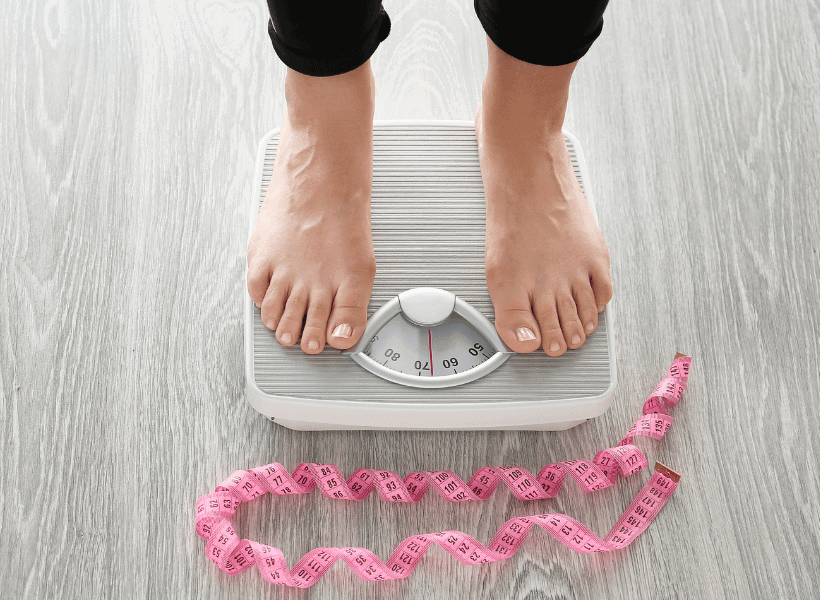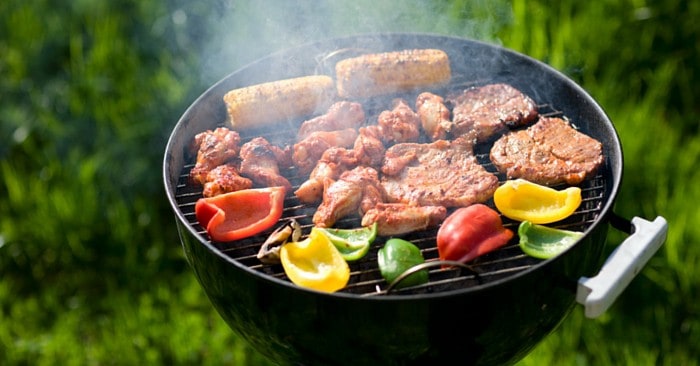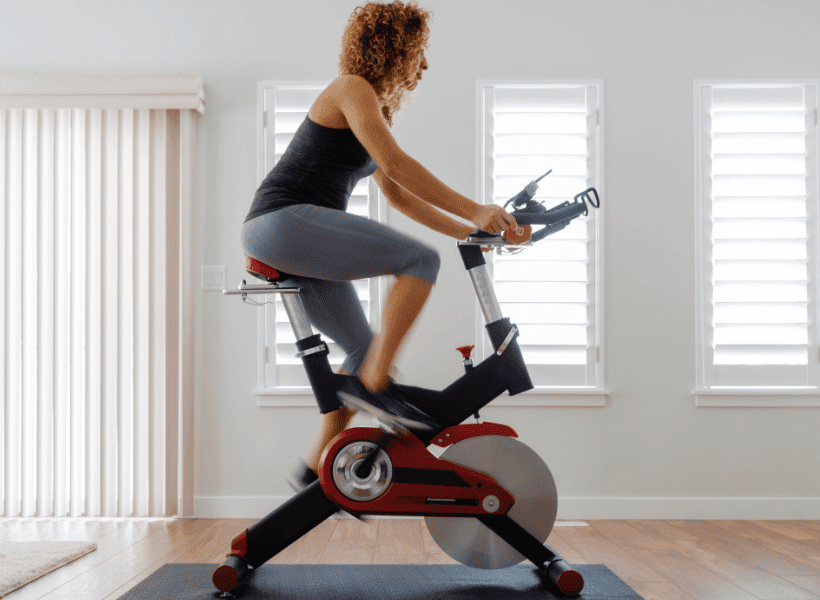Losing weight is a difficult process that takes time and commitment. How much weight can you lose in a month? 5 lbs? 10 lbs? 20 lbs? With the right strategy, you can reach your weight loss goals! It’s not uncommon for people to want to shed excess body fat quickly. Forget the fad diets. Losing weight should be done in a safe, healthy way that will set you up for long-term weight loss.
And although for some, gaining weight is easy and fast, let’s face it, shedding those extra pounds is not that easy nor quick. However, if you want to start your weight loss plan and see results within a month, it is entirely possible!

When I got serious and on the right path to losing weight after 40, I started seeing results quickly. I’m happy to share specific tips that will help you have the same results.
I won’t say it will be easy. Habits will need to change some, but I’ll give you the tools needed to make these lifestyle changes. Once you become lean and fit, looking 20 years younger, you’ll want to stay that way. Following these tips, you’ll learn how to feel satisfied eating a sustainable healthy diet and toned with workouts and exercise you’ll be able to fit into your busy life.
This way you can continue to lose weight and practice healthy habits even after the month is over!
Can I Lose Weight in a Month?
Absolutely! To lose weight in 30 days, you need to burn more calories than your body consumes. Staying in a calorie deficit (less calories in than you are burning), while balancing macros, will result in gradual weight loss (a rapid weight loss would not be sustainable) with fat stores being consumed for energy needs. Fat will be converted into energy for your body rather than continuing to store fat.
This means that it’s possible to lose a weight in a month if you’re able to exercise more and eat the right foods.
However, losing extreme weight in 20 or 30 days is not always healthy or sustainable because it might interfere with your body’s natural ability to regulate the amount of nutrients available for essential functions such as tissue repair. If you go too extreme with your diet and don’t commit to changing your lifestyle, you will most likely gain the weight back that you worked so hard to lose.
How Much Weight Can I Lose in a Month?
Let’s be honest, all over the internet, we can find diets and workout programs with screamer headlines like “drop TEN pounds in just TEN DAYS!!!”, but we know that’s not possible. Well, it can be possible, but it’s not healthy way, and you’re pretty much guaranteed to gain it all back and then some. It’s essential to set realistic weight loss goals, especially when giving yourself a set amount of time to work with.
According to the Centers for Disease Control and Prevention, the amount of weight you can healthily lose per week is 1 to 2 pounds. This estimate makes you more likely to keep weight off long-term and fits perfectly with someone who’s just starting their fitness journey.
Therefore, in a month, you could lose 4 – 8 pounds. Remember, a pound of fat in volume is HUGE, so don’t let the “measly” numbers hold you back from reaching your goals.
When you combine your calorie deficit plan with an exercise plan, your results can be many, many inches lost in addition to the 4-8 lbs on the scale.
How To Set Your Monthly Weight Loss Goal

The first step to your monthly weight loss goal is to follow the SMART scheme. This scheme will not only work for your monthly weight loss goal but also for a 20 day or any other goal you want to achieve (you’re welcome!).
SMART Scheme Plan
- Specific: Be clear about what you want to achieve. Write down on a notebook or paper your weight goal is and try to add as many details as possible.
- Measurable: You need to keep track of your progress, so how will you do it? Will you measure body weight, BMI, exercise performance, or all of the above?
- Attainable: Do you have the time, resources, and motivation to reach your weight loss goal?
- Realistic: Considering your current weight and the factors above, do you think losing 2 pounds per week is realistic? Or do you think you can lose fewer pounds (or more)?
- Time-bound: Set a deadline for your fitness goal (you already have this characteristic checked – one month!) and once you meet it, stick to it.
Now let’s get to the main question…
What do I need to do to lose weight in a month?
To reduce weight in 30 days, there are key factors to follow. Eating a balanced diet and exercising, just as you’ve heard before.
These are at the core of weight loss, and if one of these two factors is missing, you are not going to achieve your goal in an optimal or healthy way. Along with those, there are some other factors that can help you lose those extra pounds in a month and keep you moving to an even healthier self, so keep scrolling!

14 Day Bootcamp Challenge to a Healthy Lifestyle
This quickstart challenge is for the women who want to know the right foods to eat, but without a set meal plan to follow. Quickly learn how to put together your own healthy meals and snacks, along with so many other important healthy principles to create a balanced healthy lifestyle. And…all in 14 days!
Through daily emails, I will share some habits and principles you can start tomorrow morning that when used consistently, you WILL lose weight. You’ll get assignments along the way to implement immediately along with help from me via email if you have any questions. This is a great way to jump right in to start transforming your life! Read more details below…
Eat a Balanced Diet
Remember when the motto was “exercise so you can eat whatever you want”? That may work for the young 20 yr olds, but not on our over 40 bodies. After 40, it’s more like, “you are what you eat” motto, no matter what else we do.
To be honest, these days, we can lose weight by just restricting our calories. However, if we don’t do any type of exercise to tone muscles, and we don’t eat the right balance of macros, the weight will come right back. Losing weight without toning muscles creates other issues as well.
Sure, we’d all like to lose weight only by doing a little exercise while still eating burgers with extra bacon and two slices of cheesecake every day, but things aren’t that easy. To lose as much weight as possible in a healthy way in a month, it has to start from your fridge.
Weight-loss diets are based on the principle of calorie deficit. By consuming fewer calories than we expend, we achieve the goal. However, this calorie restriction should not be excessive, as it can compromise our vital functions and result in the loss of water, muscle mass, and skin elasticity. The caloric deficit must ALWAYS go hand in hand with a balanced diet with tracking macros.
The first thing to do is to know our calorie requirement. This is individual for each person, depending on age, sex, and level of physical activity. On average, a woman between the ages of 31 and 50 needs 1,800 to 2,200 calories per day to perform her daily activities. This is where we must apply the caloric deficit, subtracting from our requirement approximately 500 calories per day to achieve weight loss.
I also recommend using a calorie counter like this app I coach through. (Download with this link, sign up for premium and join my team for free)
Through tracking, you can keep up with your protein (SUPER important) and general daily caloric intake.

Exercise
How important is exercise for weight loss? Very, VERY important. In fact, exercise is the second most powerful factor in healthy weight loss, as it allows you to use the calories you consume and contributes to a caloric deficit.
But exercise not only helps you lose weight, but it also helps prevent chronic diseases, improves mood, and reduces stress.
Cardio routines are the basis for losing weight by exercising. However, I highly suggest you give some thought to the possibility of doing strength exercises as well, not just cardio. Why? Well, when we tone our muscles, our metabolism increases, therefore we burn more calories throughout the day.
If you want to know more benefits of strength training for women over 40, I have a whole post dedicated to this!
Get Enough Sleep
Sleep plays an integral role in how your body stores, uses, and burns calories. When you sleep for eight hours a night on average, it can help regulate hormones that affect appetite levels as well as the amount of weight lost during dieting.
Additionally, research has shown that people who are deprived of less than six hours each day are more likely to make unhealthy food choices and are less likely to stick with their diet. Lack of sleep can lead to a negative spiral of weight gain that’s difficult for some people to break free from.
In contrast, when you sleep more than seven hours each day on average, your body releases hormones that help regulate how your body stores and uses fat during dieting. So, if you sleep more than seven hours, then you can expect to have an easier time losing weight in the long term.
Drink Enough Water
It’s no secret that drinking water is vital for the proper functioning of our body, but… Do you really know how much water you should drink daily and why hydration matters for weight loss?
Everyone should consume at least 100 oz of water per day. When your body gets dehydrated, it will start storing fat. This happens because dehydration can cause a hormone called cortisol to increase in levels. When this occurs, our bodies have difficulty burning fat cells, and of course we want to burn fat as much as possible.
When you start exercising, you have to be aware of your water intake more than ever, mainly because you can lose approximately eight glasses of water during each hour of intense cardio exercise.
Give this 30 day water challenge a try. I did it a few years ago and realized I feel best when I drink at least 120 oz a day, closer to 150 oz on hot summer days.
Additionally, drinking water may help you lose weight directly. Yup, that’s right! Studies show that drinking at least 19.6 oz of water can reduce your appetite and temporarily increase your metabolism by 30% after 30-40 minutes.
Stay Disciplined
The first week will be tough, that’s for sure. However, as the days go by, you will get used to your new routine if you really put your mind to it. Remember, no one else can make you lose weight. It’s all on you!
Make a list of why’s it’s important to you to help you stay on track, stick an encouraging post-it to yourself on the pantry door, or set alarms for your workouts with motivational descriptions. Those little things you can see throughout the day can boost your willpower and increase discipline.
If you can get a partner (or a supportive coach) who also wants to challenge themselves to lose weight in a month, the whole process could be easier for you. Having a companion will not only make you feel less alone along the way, but it will also subconsciously remind you every day why you started and what your goal is. Go find that fitness buddy and stay perseverant!
What is a Sample Balanced Diet Meal Plan?
What makes up a balanced diet? A healthy diet combines all food groups dairy, vegetables, fruits, meats, and fats. The combination of them in a macro balanced, whole foods way and adapted to individual energy needs is essential to maintain health while losing weight.
I’ll give you a simple, balanced diet meal plan so that you have a rough idea of what options you have when you want to lose weight. For more healthy recipes, feel free to check out my latest meal plan; it even includes calories, macros, and printable shopping lists!

Breakfast
For breakfast, you can make a simple but absolutely delicious bowl of Greek yogurt with berries:
– A cup of the berries of your choice (strawberries, blueberries, or raspberries, etc)
– Greek yogurt without added sugar or 1 cup of oatmeal
– Chia (optional)
– Eggs on the side (2)
Lunch
– Grilled chicken breast or other lean meat
– Dark green lettuce salad with cherry tomato, cucumber, and sweet corn
– Avocado (1/4)
– Macro conscious salad dressing
Just throw the chicken breast on the grill, prepare your salad with avocado as a side dish, and voila, healthy but delicious lunch!
Dinner
– Lean meat of your choosing (4-6 oz) – air fryer after marinading or dry seasoning added
– Roasted vegetables lightly coated with Extra Virgin Olive Oil, salt and pepper to taste
– Couscous or quinoa – could toss it with the vegetables
Additional healthy meals that are both delicious and easy can be found on this site for your convenience.
Also, if you are having a hard time adapting to new breakfast-lunch-dinner eating habits, you can use meal replacement shakes to fill in gaps with or without meals.
Meal replacement shakes are products intended to replace the nutritional value of a meal but with a lower total calorie intake. A good quality meal replacement shake should have at least 20 grams of protein, fiber, carbs and fats along with other nutrients to fuel your body.
Healthy Snacks
Snacks are perfect for when we get hungry between our usual meal times, but eating chips or candy is not a very healthy thing to do so… Just snack smarter!
Think of snacks as mini-meals. They too should have all 3 macros represented – carbs, fats and protein.
Just beware of “healthy snacks” such as nuts and fruit. While there is a great place in our diets for both, make sure to measure and track. Nuts are very high in healthy fats and can take a large chunk out of your daily allotment. Fruits are great for nutrients and fiber, but some can be higher in carbs that you may realize.
Weight Loss Exercises

You have a month to meet your goal, so you want to be as productive with your time as you can. Save time on searching for daily workouts by committing to one or two of these 30 day challenges. Choosing some type of strength training along with a 30 day walking challenge is a great well-rounded exercise program.
If you are new to working out, as I was 10 years ago, here’s a little info on some popular styles you may be introduced to.
HIIT
HIIT stands for high-intensity interval training. During a HIIT workout, you alternate short periods of highly intense cardio exercise or aerobic exercise with short recovery periods. Its success lies in the fact that our metabolism increases when reaching high intensities and high body temperature, and our body continues to the fat loss while recovering for up to 24 hours after your workout.
Another great benefit to a HIIT workout is that it rarely goes past 30 minutes, which means you don’t have to sacrifice much time in your day to stay fit. If you need a beginner HIIT routine, I’ve got it for you! Add it to your workout plan 1-2 times a week.
Treadmill
If you take my advice about walking daily and the weather isn’t the best, a treadmill at home is perfect. I walk or run on ours every day. Here, you can find a large variety of treadmill workouts no matter what your fitness level is.
Walking and running are two well-round exercises for your health, and although for many it is difficult to leave the house to walk or run, with a treadmill, there is no excuse. In addition to allowing you to burn calories, it strengthens your legs and improves your stamina.
Strength Exercises
Finally, I strongly suggest that you compliment the cardio exercises mentioned above with resistance training. Don’t worry. You won’t bulk up like the Hulk. Strength exercises will simply help you tone up and speed up your metabolism while losing weight and beyond. They can also improve your bone density, reduce the risk of arthritis and strengthen your joints. What more could you ask for?
I have a 4 Week Beginner’s Strength Training Workout with different sets of exercises, select the ones you like the most and adapt them to your 30-day plan.
Summary
No more uncertainty, now you know that you can safely lose about 4- 8 pounds in a month, and many, many inches! As long as you maintain a daily routine of a balanced diet focused on macros, have a consistent exercise routine, get enough sleep, drink enough water, and stay disciplined, it is entirely possible to lose weight in a month. Your overall health will be improved with some permanent changes supporting a sustainable weight loss and healthy lifestyle.




10 Minute Mail Gmail
Tuesday 24th of June 2025
From start to finish, your content is simply amazing. You have a talent for making complex topics easy to understand and I always come away with valuable insights.
Kendal Boyd
Sunday 22nd of June 2025
Scalable Hosting Solutions for Growing Businesses: Complete Guide - https://digitalfinds.reviewfriendly.com/scalable-hosting-solutions/
Anika Scott
Tuesday 3rd of June 2025
Treat yourself—your jewelry box is crying for an upgrade! 💖 https://bit.ly/jewelry-colleciton
Frida Kline
Monday 2nd of June 2025
Great insight! Managing cloud servers often seems complex, but Cloudways takes the stress out of the equation. Their platform delivers powerful performance without the usual technical headaches. It’s an ideal solution for those who want scalable hosting without getting lost in server configurations. Definitely worth checking out for a smoother hosting journey. Keep up the excellent work! Explore more through the link.
Bryson Bullock
Monday 19th of May 2025
Supercharge your online business with the ultimate managed hosting solution — experience speed, security, and simplicity with Cloudways!